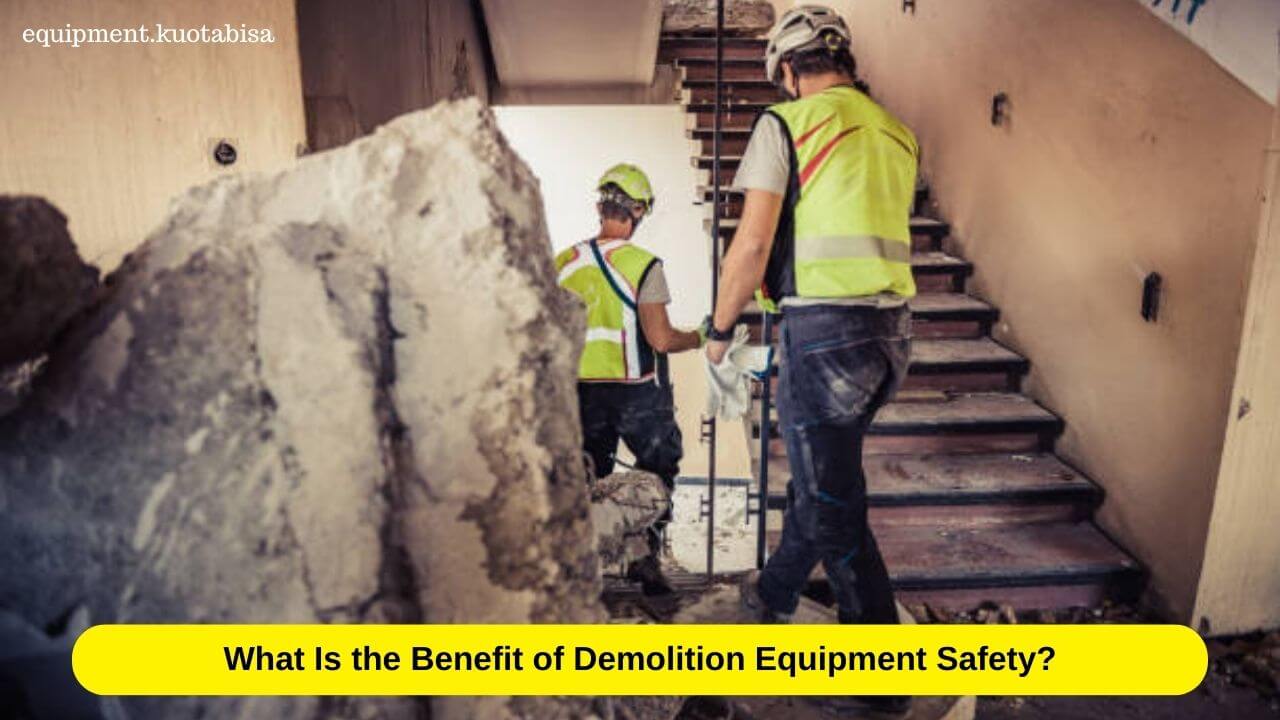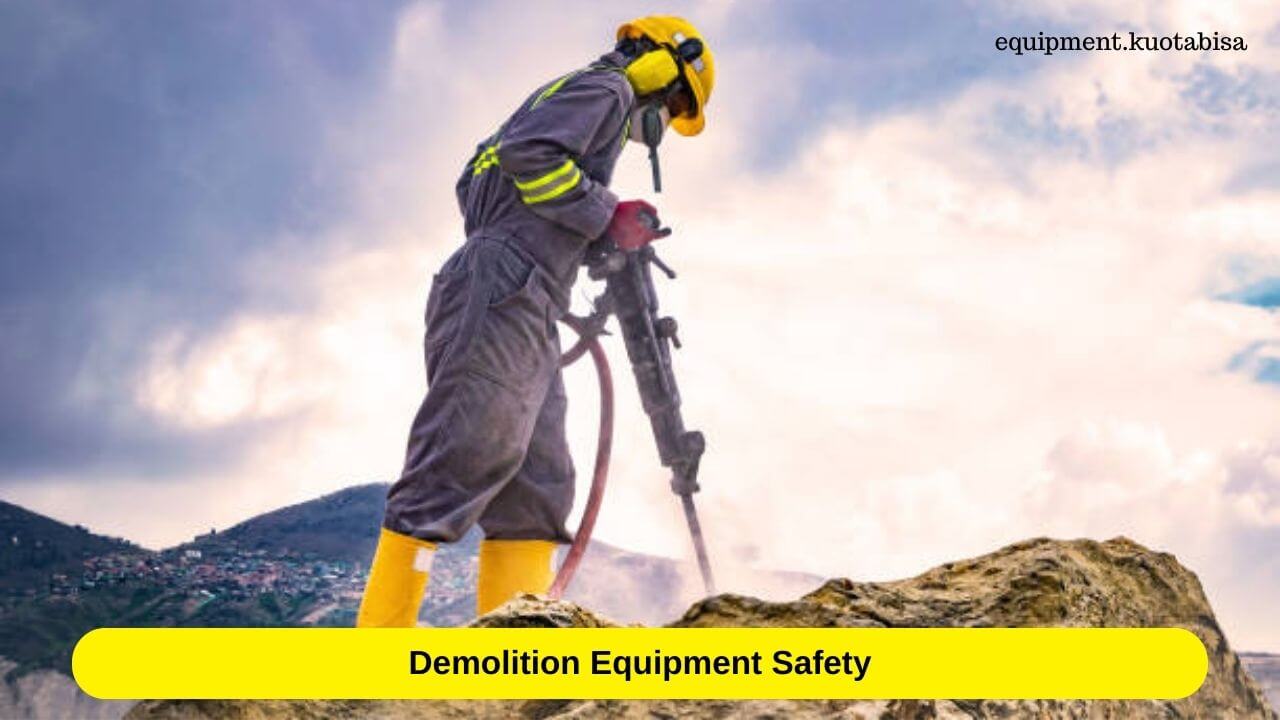Demolition Equipment Safety – Demolition is a controlled process of dismantling, removing, or destroying structures, buildings, or infrastructure to make way for new construction, renovation, or repurposing of land.
It involves the strategic use of heavy machinery, explosives, or manual labor, depending on the scale and complexity of the project.
Demolition requires meticulous planning, including site assessment, hazard identification, and the development of safety protocols to ensure the protection of workers, nearby structures, and the environment.
Precise execution and adherence to safety guidelines are paramount to prevent accidents, minimize environmental impact, and achieve a successful transition from old to new.
Post-demolition, materials recycling and proper waste disposal play a crucial role in sustainable construction practices.
What Is the Benefit of Demolition Equipment Safety?

The benefits of demolition equipment safety are significant and encompass various aspects that contribute to the overall success of a demolition project and the well-being of all involved.
These benefits include:
Worker Protection
Prioritizing safety protects the health and lives of workers operating demolition equipment.
By following proper safety protocols, workers are less likely to be injured or involved in accidents, ensuring their physical well-being.
Accident Prevention
Implementing safety measures and guidelines reduces the risk of accidents, equipment malfunctions, and structural collapses, preventing potential injuries, fatalities, and property damage.
Project Efficiency
When safety protocols are followed, work can proceed more smoothly and efficiently.
Reduced downtime due to accidents or unsafe conditions allows for consistent progress, keeping the project timeline on track.
Cost Savings
Avoiding accidents and equipment damage due to negligence translates into cost savings.
Reduced medical expenses, equipment repair or replacement, and potential legal liabilities contribute to the financial well-being of the project.
Regulatory Compliance
Adhering to safety regulations and guidelines ensures compliance with industry standards and government regulations.
This not only prevents legal issues but also demonstrates a commitment to ethical practices and responsible construction.
Reputation and Trust
A commitment to demolition equipment safety fosters a positive reputation within the industry and among clients.
Demonstrating care for the well-being of workers and the environment establishes trust and credibility.
Environmental Preservation
Safety protocols often include measures to minimize environmental impact, such as proper disposal of hazardous materials, dust control, and noise reduction.
This contributes to sustainable and responsible construction practices.
Community Safety
Implementing safety measures protects not only workers but also nearby residents, pedestrians, and neighboring properties from potential hazards, debris, and accidents.
Long-Term Viability
Properly maintained and operated equipment has an extended lifespan.
Safety practices that prevent equipment wear and tear ultimately contribute to the equipment’s longevity and operational efficiency.
Workplace Morale
culture of safety fosters positive workplace morale, as workers feel valued and supported.
This can lead to increased job satisfaction, higher productivity, and lower turnover rates.
Learning and Continuous Improvement
Emphasizing safety encourages ongoing training and learning.
Regular safety updates and improvements help workers stay updated with the latest practices and technologies in the field.
In summary, the benefits of demolition equipment safety encompass not only the immediate protection of workers but also extend to project efficiency, financial savings, compliance, reputation, and the broader well-being of the community and the environment.
Prioritizing safety is a foundational element for successful, ethical, and responsible demolition operations.
Demolition Equipment Safety

Demolition equipment safety is of paramount importance to prevent accidents, protect workers, and ensure the successful execution of demolition projects.
Operating heavy machinery in a demolition setting carries inherent risks, but with proper training, adherence to safety protocols, and the use of appropriate protective measures, these risks can be minimized.
Here are key aspects of demolition equipment safety:
Training and Certification
All operators should receive comprehensive training specific to the type of demolition equipment they will be using.
Proper training covers equipment operation, safety procedures, emergency protocols, and hazard recognition.
Certification programs, such as those provided by industry organizations, can validate an operator’s competency in handling demolition machinery.
Pre-Task Planning
Before starting any demolition task, thorough planning is essential. Identify potential hazards, assess the work environment, and develop a detailed demolition plan that includes safety measures and emergency response strategies.
Personal Protective Equipment (PPE)
Workers must wear appropriate PPE, including hard hats, safety glasses, hearing protection, high-visibility clothing, gloves, and steel-toed boots, to safeguard against falling debris, noise, and other potential hazards.
Machine Inspection and Maintenance
Regular inspection and maintenance of demolition equipment are critical.
Ensuring that the machinery is in proper working condition reduces the likelihood of unexpected malfunctions during operation.
Equipment Selection and Suitability
Choose equipment that is suitable for the specific demolition task.
Different types of equipment may be required for various materials, structures, and site conditions.
Site Isolation and Communication
Establish clear boundaries around the demolition area to prevent unauthorized access.
Effective communication between equipment operators, ground personnel, and site supervisors is vital to ensure everyone is informed and safe.
Debris Management
Implement a debris management strategy to prevent debris from falling onto workers or neighboring areas. Use protective barriers and netting to contain debris.
Emergency Response and Evacuation Plans
Develop and communicate emergency response plans that outline evacuation routes, assembly points, and procedures for addressing accidents, fires, and equipment malfunctions.
Avoiding Overloading and Structural Weakness
Operators should avoid overloading equipment beyond its capacity, as well as be cautious when demolishing structures to prevent unexpected collapses that could endanger workers.
Environmental Considerations
Consider environmental impacts during demolition, such as dust and air quality.
Implement dust suppression measures to protect both workers and the surrounding environment.
Risk Assessment and Mitigation
Regularly assess the risks associated with the demolition process and implement strategies to mitigate them.
This includes identifying unstable structures, hazardous materials, and potential underground utilities.
Continuous Training and Communication
Safety protocols and best practices should be consistently reinforced through ongoing training and open communication among all workers involved in the demolition project.
By prioritizing safety measures and fostering a culture of vigilance and responsibility, demolition equipment can be operated effectively while minimizing the potential risks to workers, the public, and the environment.
Conclusion
Demolition equipment safety is paramount to safeguard workers, structures, and the environment during the dismantling process.
Adhering to safety protocols minimizes the risk of accidents, equipment malfunctions, and structural collapses, ensuring worker well-being and preventing property damage.
By prioritizing demolition equipment safety, projects can proceed efficiently, costs can be minimized, and a commitment to responsible construction practices can be demonstrated.